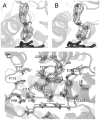Plasticity of CYP2B enzymes: structural and solution biophysical methods
- PMID: 22208531
- PMCID: PMC3879780
- DOI: 10.2174/138920012798918417
Plasticity of CYP2B enzymes: structural and solution biophysical methods
Abstract
In the past three years, major advances in understanding cytochrome P450 2B (CYP2B) structure-function relationships have been made through determination of multiple ligand-bound and one ligand-free X-ray crystal structure of CYP2B4 and one ligand-bound X-ray crystal structure of CYP2B6. These structures have provided insight into the features that provide the high degree of plasticity of the enzymes. A combination of a phenylalanine cluster that allows for concerted movement of helices F through G and a conserved set of electrostatic interactions involving Arg(262) facilitates movement of this region to accommodate binding of ligands of various sizes without perturbing most of the P450 fold. Integrating solution based techniques such as NMR or deuterium exchange mass spectrometry (DXMS) with computational methods including molecular docking has provided further insight into enzyme behavior upon ligand binding. In addition, extended molecular dynamics simulations have provided a link between an open and a closed conformation of ligand-free CYP2B4 found in crystal structures. Other studies revealed the utility of rational engineering in improving stability of P450s to facilitate structural studies. The solution and computational results combined with the X-ray crystal structures yield a comprehensive picture of how these enzymes adopt different conformations to bind various ligands.
Figures





Similar articles
-
Plasticity of cytochrome P450 2B4 as investigated by hydrogen-deuterium exchange mass spectrometry and X-ray crystallography.J Biol Chem. 2010 Dec 3;285(49):38602-11. doi: 10.1074/jbc.M110.180646. Epub 2010 Sep 28. J Biol Chem. 2010. PMID: 20880847 Free PMC article.
-
Structure and function of cytochromes P450 2B: from mechanism-based inactivators to X-ray crystal structures and back.Drug Metab Dispos. 2011 Jul;39(7):1113-21. doi: 10.1124/dmd.111.039719. Epub 2011 Apr 18. Drug Metab Dispos. 2011. PMID: 21502194 Free PMC article.
-
Structure-function analysis of cytochromes P450 2B.Biochim Biophys Acta. 2007 Mar;1770(3):402-12. doi: 10.1016/j.bbagen.2006.07.006. Epub 2006 Jul 22. Biochim Biophys Acta. 2007. PMID: 16935426 Review.
-
Effect of detergent binding on cytochrome P450 2B4 structure as analyzed by X-ray crystallography and deuterium-exchange mass spectrometry.Biophys Chem. 2016 Sep;216:1-8. doi: 10.1016/j.bpc.2016.05.007. Epub 2016 Jun 1. Biophys Chem. 2016. PMID: 27280734 Free PMC article.
-
Thermodynamics of ligand binding to P450 2B4 and P450eryF studied by isothermal titration calorimetry.Drug Metab Rev. 2007;39(2-3):539-56. doi: 10.1080/03602530701498182. Drug Metab Rev. 2007. PMID: 17786637 Review.
Cited by
-
The dynamics of camphor in the cytochrome P450 CYP101D2.Protein Sci. 2013 Sep;22(9):1218-29. doi: 10.1002/pro.2309. Epub 2013 Aug 12. Protein Sci. 2013. PMID: 23832606 Free PMC article.
-
A large-scale allosteric transition in cytochrome P450 3A4 revealed by luminescence resonance energy transfer (LRET).PLoS One. 2013 Dec 23;8(12):e83898. doi: 10.1371/journal.pone.0083898. eCollection 2013. PLoS One. 2013. PMID: 24376769 Free PMC article.
-
Structure-Function Analysis of Mammalian CYP2B Enzymes Using 7-Substituted Coumarin Derivatives as Probes: Utility of Crystal Structures and Molecular Modeling in Understanding Xenobiotic Metabolism.Mol Pharmacol. 2016 Apr;89(4):435-45. doi: 10.1124/mol.115.102111. Epub 2016 Jan 29. Mol Pharmacol. 2016. PMID: 26826176 Free PMC article.
-
Ring-oxidative biotransformation and drug interactions of propofol in the livers of rats.Biomed Res Int. 2015;2015:658928. doi: 10.1155/2015/658928. Epub 2015 Feb 1. Biomed Res Int. 2015. PMID: 25710017 Free PMC article.
-
So many roads traveled: A career in science and administration.J Biol Chem. 2020 Jan 17;295(3):822-832. doi: 10.1074/jbc.X119.012206. J Biol Chem. 2020. PMID: 31953248 Free PMC article.
References
-
- Johnson EF, Stout CD. Structural diversity of human xenobiotic-metabolizing cytochrome P450 monooxygenases. Biochem Bioph Res Co. 2005;338(1):331–336. - PubMed
-
- Wang H, Negishi M. Transcriptional regulation of cytochrome P450 2B genes by nuclear receptors. Curr Drug Metab. 2003;4(6):515–525. - PubMed
-
- Zhao Y, Halpert JR. Structure-function analysis of cytochromes P450 2B. BBA-Gen Subjects. 2007;1770(3):402–412. - PubMed
-
- Lewis DFV, Lake BG, Ito Y, Anzenbacher P. Quantitative structure-activity relationships (QSARS) within cytochromes P450 2B (CYP2B) subfamily enzymes: The importance of lipophilicity for binding and metabolism. Drug Metabol Drug Interact. 2006;21(3–4):213–31. - PubMed
-
- Lewis DFV, Ito Y, Lake BG. Quantitative structure-activity relationships (QSARS) for inhibitors and substrates of CYP2B enzymes: Importance of compound lipophilicity in explanation of potency differences. J Enzym Inhib Med Ch. 2010;25(5):679–684. - PubMed
Publication types
MeSH terms
Substances
Grants and funding
LinkOut - more resources
Full Text Sources
Miscellaneous

